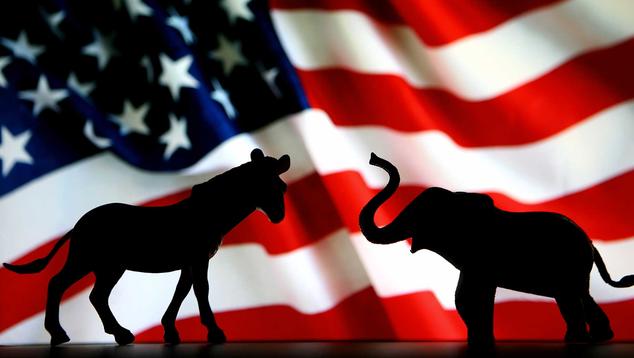Story Highlights
- 37% have positive view of Republican Party, down from 43%
- 48% have positive view of Democratic Party
- Republicans' favorable rating of GOP down 12 points
WASHINGTON, D.C. -- Americans' opinions of the Republican Party have worsened in recent months, with 37% now saying they have a favorable view of the party, down from 43% in November. This decline, along with a slight increase in the Democratic Party's positive ratings, to 48%, gives the Democrats a rare double-digit advantage in favorability.
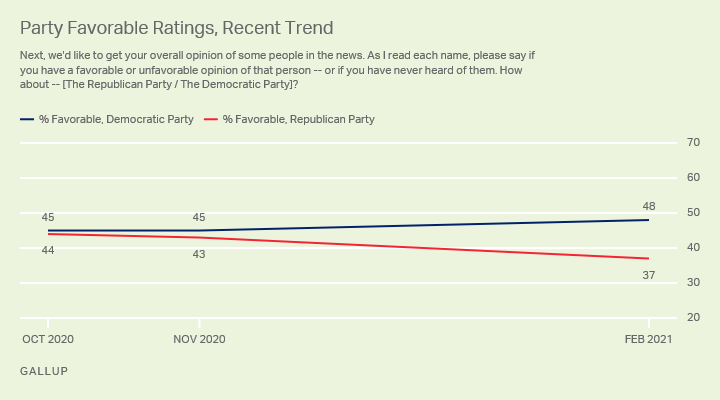
Line graph. Since November, favorable ratings of the Republican Party have fallen from 43% to 37%, while favorable ratings of the Democratic Party are up from 45% to 48%.
The Jan. 21-Feb. 2 poll was conducted in the weeks after the Jan. 6 storming of the U.S. Capitol by people seeking to disrupt the counting of the 2020 presidential election electoral votes. Former president Donald Trump is on trial this week in the U.S. Senate after the House of Representatives filed impeachment charges against him for his actions leading up to those riots. Most Republicans in the House voted against impeaching Trump, and most Republican senators objected to the trial proceeding in a Jan. 26 vote on the constitutionality of convicting a former president of impeachment charges.
Since November, the GOP's image has suffered the most among Republican Party identifiers, from 90% favorable to 78%. Independents' and Democrats' opinions are essentially unchanged.
| November 2020 | February 2021 | Change | |||||||||||||||||||||||||||||||||||||||||||||||||||||||||||||||||||||||||||||||||||||||||||||||||
|---|---|---|---|---|---|---|---|---|---|---|---|---|---|---|---|---|---|---|---|---|---|---|---|---|---|---|---|---|---|---|---|---|---|---|---|---|---|---|---|---|---|---|---|---|---|---|---|---|---|---|---|---|---|---|---|---|---|---|---|---|---|---|---|---|---|---|---|---|---|---|---|---|---|---|---|---|---|---|---|---|---|---|---|---|---|---|---|---|---|---|---|---|---|---|---|---|---|---|---|
| % | % | Pct. Pts. | |||||||||||||||||||||||||||||||||||||||||||||||||||||||||||||||||||||||||||||||||||||||||||||||||
| U.S. adults | 43 | 37 | -6 | ||||||||||||||||||||||||||||||||||||||||||||||||||||||||||||||||||||||||||||||||||||||||||||||||
| Republicans | 90 | 78 | -12 | ||||||||||||||||||||||||||||||||||||||||||||||||||||||||||||||||||||||||||||||||||||||||||||||||
| Independents | 33 | 32 | -1 | ||||||||||||||||||||||||||||||||||||||||||||||||||||||||||||||||||||||||||||||||||||||||||||||||
| Democrats | 9 | 10 | +1 | ||||||||||||||||||||||||||||||||||||||||||||||||||||||||||||||||||||||||||||||||||||||||||||||||
| Gallup | |||||||||||||||||||||||||||||||||||||||||||||||||||||||||||||||||||||||||||||||||||||||||||||||||||
Meanwhile, the slight increase in positive ratings of the Democratic Party is being driven by independents, who show a seven-percentage-point jump in favorability since November, 41% to 48%. Ninety-four percent of Democrats (compared with 92% in November) and 4% of Republicans (compared with 5% in November) rate the Democratic Party favorably.
Republican Party Favorability Has Often Been Below 40%
Sub-40% favorable ratings for the Republican Party are not unusual. The last such measure was 38% in January 2019 amid the partial federal government shutdown related to a dispute over funding for Trump's proposed southern border wall. From 2013 through 2018, the average favorable rating for the GOP was 39%.
In contrast to those generally weak ratings, in January 2020, a slim majority of Americans viewed the Republican Party favorably while Trump was in the process of being acquitted in his first impeachment trial, and the U.S. economy was strong.
The current GOP image reading is still significantly above the party's historical low rating of 28% from October 2013, when disputes over funding the Affordable Care Act led to a partial government shutdown. Gallup also measured a low 31% reading for the GOP in December 1998 after Bill Clinton was impeached by the Republican-led House of Representatives.
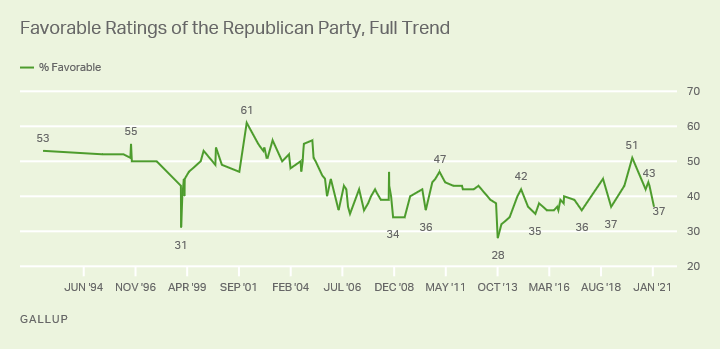
Line graph. Full trend on favorable ratings of the Republican Party. Gallup's initial favorable rating of the Republican Party in 1992 was 53%. In December 1998, its favorable rating dropped to 31%. It reached a high of 61% in early 2002 after the September 11, 2001 terror attacks. Since 2006, it has frequently been below 40%, including a low of 28% in October 2013.
Democratic Party Usually Has Edge in Favorability
The Democratic Party is typically rated more positively than the Republican Party, likely because more Americans align themselves politically with the Democrats than the Republicans. Still, double-digit Democratic advantages have been uncommon, last occurring during the 2013 shutdown and in the months after.
Democrats also held a double-digit edge in favorability for much of George W. Bush's second term in office, in early 2004 during the Democratic presidential primaries, during the Clinton impeachment period in late 1998 and early 1999, and after the 1996 Democratic convention.
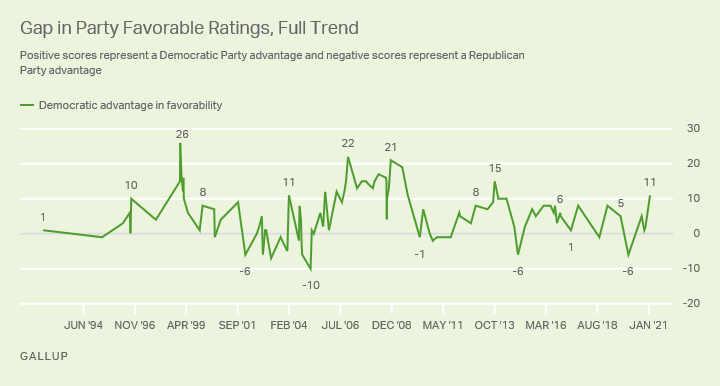
Line graph. Difference in Gallup party favorable ratings. Most of the times the Democratic Party has a higher favorable rating than the Republican Party. The largest advantage of 26 points came in December 1998. The Democrats also enjoyed 20-points advantages in November 2006 and November 2008 after the elections in those years. The current 11-point advantage is among the largest. Republicans last held a six-point advantage in January 2020. Their largest was 10 points in February 2005.
While the Democratic Party is usually rated better than the Republican Party, the Democratic Party's ratings have not been strong, either. The last time the Democrats had a favorable rating above 50% was in November 2012 after Barack Obama won a second term as president.
Historically, from Gallup's first measurement of party favorability in 1992 until early in Obama's first term, Democrats usually had favorable ratings above 50%. Its low point was 36% in November 2014 after the party lost control of the U.S. Senate in that year's midterm elections.
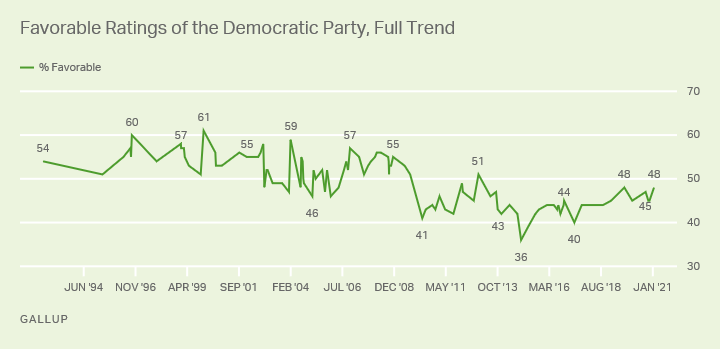
Line graph. Full trend on favorable ratings of the Democratic Party. Gallup's initial favorable rating of the Democratic Party in 1992 was 54%. Most of its ratings through 2009 were above 50%. Since then, all but one rating have been below 50%, including a low of 36% in November 2014 after a poor showing in the midterm elections.
Implications
The tumultuous end to the Trump presidency appears to have harmed the image of the Republican Party. The GOP now faces a double-digit deficit in favorable ratings compared with the Democratic Party.
With much of the decline in Republican Party favorability coming from Republicans themselves, the GOP faces a crossroads, as it decides whether to continue to be loyal to Trump, his political style and his favored policy positions or break with him. Currently, 60% of Republicans and Republican-leaning independents say they want Trump to continue to lead the party, while 38% would prefer a new leader.
History has shown that changes in party images can be temporary and subject to major political events. Barely a year after the GOP's all-time low favorable rating in 2013, the party won back control of the Senate in the midterm elections.
With Trump's impeachment trial underway, it is notable that past impeachment efforts have tended to harm the image of the party pursuing the changes -- Republicans in 1998 and Democrats in 2020. One difference between the current impeachment effort and the two most recent ones, though, is that more Americans want to see Trump convicted than acquitted. In 1998 and 2020, Americans opposed convicting the president.
Next year's midterm presents an opportunity for the Republican Party to win back one or both houses of Congress, since the party of the incumbent president usually loses seats. With the Democrats holding narrow majorities in both houses, the Republicans need to pick up only a small number of seats to regain the majority. But if the Republican party is still internally divided over whether to maintain loyalty to Trump or move beyond Trump next year, it could create a barrier, especially if bruising GOP primaries between Trump loyalists and non-loyalists and weaken the party nominees in the general election.
View complete question responses and trends (PDF download).
Learn more about how the Gallup Poll Social Series works.
